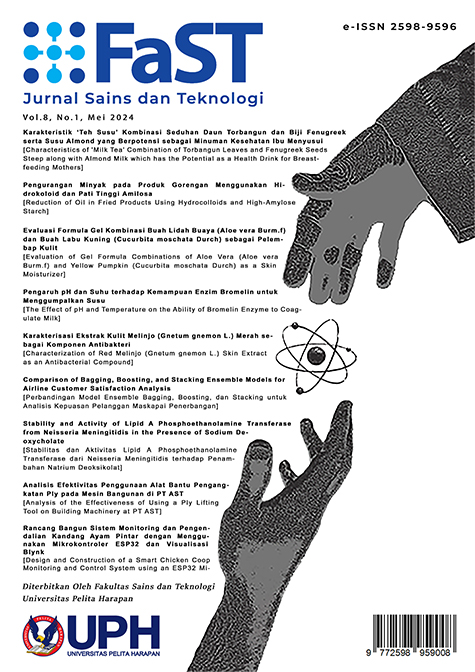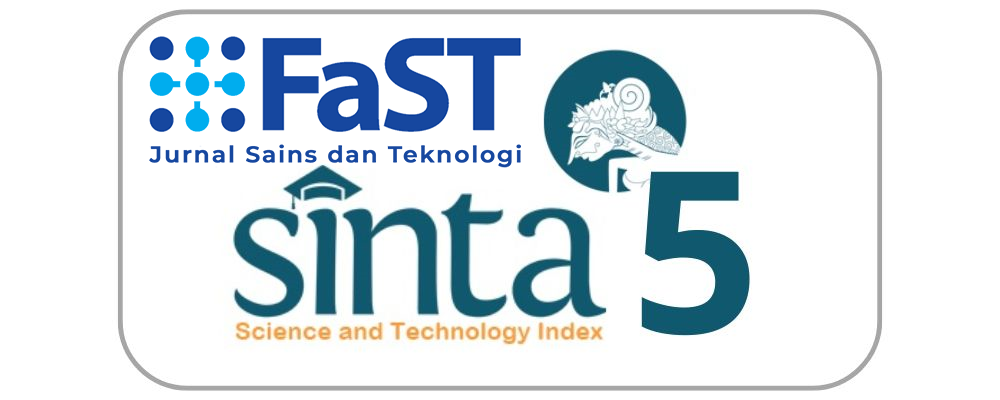RANCANG BANGUN SISTEM MONITORING DAN PENGENDALIAN KANDANG AYAM PINTAR DENGAN MENGGUNAKAN MIKROKONTROLER ESP32 DAN VISUALISASI BLYNK [DESIGN AND CONSTRUCTION OF A SMART CHICKEN COOP MONITORING AND CONTROL SYSTEM USING AN ESP32 MICROCONTROLLER AND BLYNK VISUALIZATION]
DOI:
https://doi.org/10.19166/jstfast.v8i1.8335Keywords:
Blynk, Internet of Things (IoT), ESP32 Microcontroller, chicken farms, chicken coops, smart farming, peternakan ayam, sistem monitoring dan kontrol, monitoring and control systemAbstract
Many chicken farmers in Indonesia still rely on conventional approaches in their operations, including manual feeding, watering, and temperature control. The aim of this research is to design and build an IoT-based smart chicken coop system. This system will allow for more accurate monitoring of factors affecting poultry production, such as temperature conditions, air humidity, feed and water supply, and automatic lighting. With this system, farmers can make more efficient and quick decisions, which will ultimately increase productivity and welfare of chickens, as well as optimize resource utilization. The IoT platform used to run the monitoring process in the smart coop is Blynk. Utilizing Blynk will assist farmers in collecting data, visually illustrating, and analyzing data in real time. Testing was conducted on four subsystems of the coop design, where the results of component testing and sensor calibration found that the DHT22 temperature and humidity sensor has an average reading discrepancy of 0.75%, the LDR light sensor has accurate values in room conditions, the ultrasonic sensor has an average reading discrepancy of 0.9%, while the water level sensor can provide accurate detection on water thus it can be used as a platform for monitoring. The results of functional test of the system as a whole, showed that the system works very well, making it effective to be a solution for chicken farmers.
Bahasa Indonesia Abstract:
Peternak ayam banyak yang masih mengandalkan pendekatan konvensional dalam operasional peternakannya, termasuk pemberian pakan, air minum, dan pengaturan suhu yang dilakukan secara manual. Tujuan dari penelitian ini adalah merancang dan membangun sistem kandang ayam pintar berbasis IoT. Sistem ini akan memungkinkan pemantauan yang lebih tepat terhadap faktor-faktor yang memengaruhi produksi ayam unggas, seperti kondisi suhu, kelembaban udara, pasokan pakan dan air, serta pencahayaan otomatis. Dengan adanya sistem ini, peternak dapat membuat keputusan yang lebih efisien dan cepat, yang pada akhirnya akan meningkatkan produktivitas dan kesejahteraan ayam, serta mengoptimalkan penggunaan sumber daya. Platform IoT yang digunakan untuk menjalankan proses pemantauan di dalam kandang adalah Blynk. Pemanfaatan Blynk akan membantu peternak dalam mengumpulkan data, menggambarkan secara visual, dan menganalisis data secara real time. Pengujian dilakukan terhadap empat proses dari perancangan alat ini, di mana dari hasil pengujian per komponen dan kalibrasi sensor didapatkan bahwa sensor suhu dan kelembapan DHT22 mempunyai selisih bacaan sebesar 0.75%, sensor cahaya LDR mempunyai nilai yang akurat pada kondisi ruangan, sensor ultrasonik mempunyai selisih bacaan sebesar 0.9%, dan sensor water level dapat memberikan deteksi yang akurat pada air sehingga dapat digunakan sebagai platform untuk monitoring. Dari hasil pengujian fungsional sistem secara keseluruhan didapatkan bahwa sistem bekerja sangat baik, sehingga sistem efektif untuk menjadi solusi bagi peternak ayam.
References
Alvin, J., & Ilham, M. (2020). Prototype design of monitoring and control system in broiler chicken coop based on Internet of Things (IoT). Retrieved October 25, 2023 from http://library.palcomtech.com/pdf/6714.pdf
Dinas Ketahanan Pangan (Dispertan Pangan). (2023). Cara berternak ayam pedaging. Retrieved October 25, 2023 from https://dinpertanpangan.demakkab.go.id/?p=4363
Junaidi, A. (2015). Internet of things, sejarah, teknologi dan penerapannya: Review. Jurnal Ilmiah Teknologi Informasi Terapan, 1(3), 62-66.
Nurjannah, B., Muis, M., Sirajuddin, A., & Beddu, H. (2021). Tingkat pengetahuan peternak terhadap berat badan broiler dengan variasi suhu pada sistem pemeliharaan kandang closed house. Jurnal Agrisistem: Seri Sosek dan Penyuluhan, 17(1), 70-78. https://doi.org/10.52625/j-agr-sosekpenyuluhan.v17i2.201
Pusat Komunikasi dan Informasi Publik (PKIP) UNAIR. (2022). Implementasi IoT dalam smart farming. Retrieved October 25, 2023 from https://unair.ac.id/implementasi-iot-dalam-smart-farming/
Puspasari, F., Satya, T. P., Oktiawati, U. Y., Fahrurrozi, I., & Prisyanti, H. (2020). Analisis akurasi sistem sensor DHT22 berbasis arduino terhadap thermohygrometer standar. Jurnal Fisika dan Aplikasinya, 16(1), 40-45. https://doi.org/10.12962/j24604682.v16i1.5776
Ramadhan, D., Hanuranto, A. T., Mayasari, R. (2020). Implementasi kandang ayam pintar berbasis Internet of Things (IoT) untuk pemantauan dan pengendalian peternakan ayam. e-Proceeding of Engineering, 7(2), 3639-3650.
Salensehe, N. W., Narasiang, B. S., & Tulung, N. M. (2021). Sistem pengontrol kandang ayam otomatis menggunakan smartphone. [Bachelor’s Thesis]. Universitas Sam Ratulangi, Manado, Indonesia.
Tambun, H. (2022). Rancang bangun kandang ayam pintar menggunakan arduino dan nodemcu dengan sistem IoT [Bachelor’s Thesis]. Universitas Medan Area, Medan, Indonesia.
Wijayanti, R. P., Busono, W., & Indrati, R. (2013). Pengaruh suhu kandang yang berbeda terhadap performans ayam pedaging periode starter [Bachelor’s Thesis]. Universitas Brawijaya, Malang, Indonesia.
Downloads
Additional Files
Published
Issue
Section
License
“Authors who publish with this journal agree to the following terms:
1) Authors retain copyright and grant the journal right of first publication with the work simultaneously licensed under a Creative Commons Attribution License (CC-BY-SA 4.0) that allows others to share the work with an acknowledgement of the work's authorship and initial publication in this journal.
2) Authors are able to enter into separate, additional contractual arrangements for the non-exclusive distribution of the journal's published version of the work (e.g., post it to an institutional repository or publish it in a book), with an acknowledgement of its initial publication in this journal.
3) Authors are permitted and encouraged to post their work online (e.g., in institutional repositories or on their website). The final published PDF should be used and bibliographic details that credit the publication in this journal should be included.”



